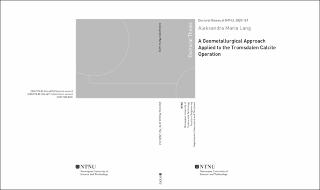| dc.contributor.advisor | Aasly, Kurt | |
| dc.contributor.advisor | Ellefmo, Steinar Løve | |
| dc.contributor.author | Lang, Aleksandra Maria | |
| dc.date.accessioned | 2020-05-13T06:14:12Z | |
| dc.date.available | 2020-05-13T06:14:12Z | |
| dc.date.issued | 2020 | |
| dc.identifier.isbn | 978-82-326-4671-5 | |
| dc.identifier.issn | 1503-8181 | |
| dc.identifier.uri | https://hdl.handle.net/11250/2654149 | |
| dc.description.abstract | The motivation behind the thesis was to increase the knowledge and to expand the possibilities within industrial mineral mining, an important mining sector in Norway. This was done through extensive deposit study and an implementation of the geometallurgical concept into Verdalskalk AS’s calcite operation. Verdalskalk operates an open-pit calcite mine in Tromsdalen. The Tromsdalen deposit is a Middle Ordovician metalimestone of high purity. Most of the raw material is calcined in a furnace to calcium oxide (CaO) and used to produce precipitated calcium carbonate (PCC).
The main focuses of the study were mineralogical and textural studies of the raw material, rock surface hardness tests and conceptual work on the development of a geometallurgical flowsheet. The studies and tests were designed to follow the concept of geometallurgy, which merges geological and processing information along the mining value chain. The objectives of the study were to expand the knowledge of the geological drivers of processing parameters in the mine, and to implement the geometallurgical approach, used widely in metalliferous mining, to industrial mineral operations through a development of a geometallurgical flowsheet. The research was summarized in three papers.
The mineralogical studies mostly used transmitted and reflected light microscopy, with additional use of scanning electron microscopy. The surface hardness tests were conducted with the use of an Equotip 3 D rebound hardness tester on the rock in the pit and on the drill half cores. The conceptual work on the geometallurgical flowsheet used the IDEF0 function modelling methodology, followed by an investigation of the company’s value chain, quality check procedures and possible bottlenecks. The research also consisted of logging the company parameters to investigate on potential areas of operation where the geometallurgical concept can be applied. Additionally, a literature review was conducted to clarify and unify geometallurgical terms and definitions.
Mineralogical studies using transmitted and reflected light microscope revealed differences in calcite grain size, trace mineral assembly and grain boundary shape between two types of marble (K2 and K5) of the same purity class. It was concluded that better mineralogical and textural control of the raw material is needed for better prediction of the kiln process. Surface hardness tests were done in-situ and on halved drill cores. The tests done in-situ followed the mineralogical investigations of marble types K2 and K5. Rebound hardness values of type K2 were higher than K5, and that finding was interpreted as being related to the presence of silica minerals. Type K2 rebound hardness data also had higher standard deviations which were related to limonitic staining of the rock. It was concluded that research should be continued on half-cores as surface smoothness and accessibility was hypothesized to be an important factor.
The surface hardness tests on drill core material were preceded by core logging that allowed classification of the marble into 14 types. The highest rebound hardness values were obtained for types M10 and M8, both characterized by the presence of dispersed graphite that is usually associated with fine-grained calcite. The coarse-grained white calcite was characterized by much lower values. A positive correlation between core diameter and mean result and between core diameter and standard deviation was found and a need for an appropriate correlation factor was highlighted, as the correction factor mentioned in the literature did not compensate for the differences in the results.
Another focus of the study has been the development of the general and the case-specific geometallurgical flowsheet. The geometallurgical flowsheet was defined as a tool for designing and communicating a geometallurgical program to establish a geometallurgical predictive model. It was proposed to be used on site, for enhanced communication between specialists. The geometallurgical model definition was clarified as a function that links georeferenced in-situ geological characteristics and georeferenced measure of performance in a processing plant, emphasizing the positioning of the geoscientific data. The term a priori model was introduced for a preliminary model that is checked and validated during the execution of a geometallurgical program. It was concluded that the IDEF0 methodology was a tool that integrates with the idea of enhanced interdisciplinary communication, which is one of the key features of geometallurgy. | |
| dc.language.iso | eng | en_US |
| dc.publisher | NTNU | en_US |
| dc.relation.ispartofseries | Doctoral theses at NTNU;2020:161 | |
| dc.relation.haspart | Paper 1: Lang, Aleksandra; Aasly, Kurt; Ellefmo, Steinar Løve. Mineral characterization as a tool in the implementation of geometallurgy into industrial mineral mining. Minerals Engineering 2018 ;Volum 116. s. 114-122
https://doi.org/10.1016/j.mineng.2017.10.021 | en_US |
| dc.relation.haspart | Paper 2: Lang,
Lang, Aleksandra Maria; Ellefmo, Steinar Løve; Aasly, Kurt. Geometallurgical Flowsheet as a Tool for Designing and Communicating Geometallurgical Programs. Minerals 2018 ;Volum 8.(9)
https://doi.org/10.3390/min8090372
This article is an open access
article distributed under the terms and conditions of the Creative Commons Attribution
(CC BY) license (http://creativecommons.org/licenses/by/4.0/). | en_US |
| dc.relation.haspart | Paper 3:
Lang, Aleksandra Maria; Ellefmo, Steinar Løve; Aasly, Kurt.
Application of rebound hardness testing to assess spatial lithological and textural variations of calcite marble | en_US |
| dc.title | A Geometallurgical Approach Applied to the Tromsdalen Calcite Operation | en_US |
| dc.type | Doctoral thesis | en_US |
| dc.subject.nsi | VDP::Technology: 500::Rock and petroleum disciplines: 510 | en_US |

